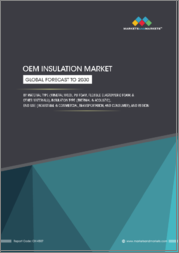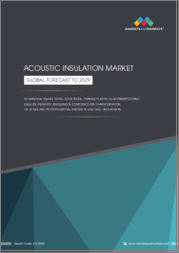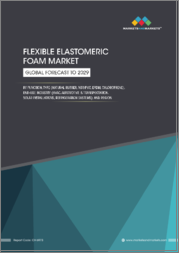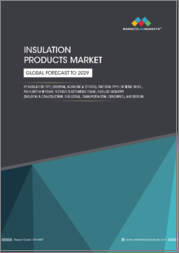
|
시장보고서
상품코드
1808319
엘라스토머 폼 시장 : 엘라스토머 유형, 폼, 셀 구조, 용도, 최종 이용 산업, 판매채널별 - 세계 예측(2025-2030년)Elastomeric Foam Market by Elastomer Type, Form, Cell Structure, Application, End-Use Industry, Sales Channel - Global Forecast 2025-2030 |
||||||
엘라스토머 폼 시장은 2024년에는 28억 2,000만 달러로 평가되었습니다. 2025년에 29억 7,000만 달러에 이르고, CAGR 5.54%로 성장하여 2030년에는 39억 달러에 달할 것으로 예측됩니다.
| 주요 시장 통계 | |
|---|---|
| 기준 연도 : 2024년 | 28억 2,000만 달러 |
| 추정 연도 : 2025년 | 29억 7,000만 달러 |
| 예측 연도 : 2030년 | 39억 달러 |
| CAGR(%) | 5.54% |
엘라스토머 폼 시장의 중요한 상황을 파악하고, 전략적 기회와 미래 성장 잠재력을 탐구합니다.
엘라스토머 폼 산업은 열 관리, 방음, 고급 쿠션 시스템 등 다양한 솔루션을 제공함으로써 현대 엔지니어링 응용 분야의 핵심으로 부상하고 있습니다. 기업이 진화하는 환경 규제와 높아지는 성능 요구 사항에 직면하고 있는 가운데, 이러한 소재는 에너지 효율 개선 노력과 거주자 편의성 목표에 필수적인 것으로 입증되고 있습니다. 이 보고서는 규제 프레임워크, 기술의 비약적인 발전, 최종 사용자의 요구 변화 등 이 시장을 형성하는 요인에 대한 명확한 견해를 제시합니다. 현재 트렌드를 매핑하고, 공급망 역학을 검토하고, 중요한 세분화를 강조함으로써 독자들은 엘라스토머 폼 솔루션이 어떻게 현재의 과제를 해결하고 미래의 발전을 예측할 수 있는지에 대한 종합적인 이해를 얻을 수 있습니다.
혁신의 지속가능성과 디지털 전환의 최전선에 서서, 엘라스토머 폼 분야를 형성하는 혁명적 요인을 탐구합니다.
최근 몇 년 동안 엘라스토머 폼 분야는 합성 화학의 혁신, 첨단 제조 기술, 지속가능성에 대한 요구가 증가함에 따라 큰 변화를 겪고 있습니다. 제조업체들은 현재 디지털 시뮬레이션 도구와 첨가제 첨가 공정을 활용하여 전례 없는 정밀도로 폼의 특성을 조정하고 있습니다. 한편, 에너지 소비 감소에 대한 규제 압력은 전 세계 탈탄소화 목표에 따라 내열성이 우수한 폐쇄형 셀 구조의 개선에 박차를 가하고 있습니다. 동시에, 재활용 원료와 바이오 유래 원료의 출현은 순환형 사회로의 전환을 강조하고 있으며, 환경적 의무와 보다 친환경적인 솔루션을 원하는 최종 사용자의 선호도를 모두 충족시키고 있습니다.
미국 내 엘라스토머 폼의 무역 역학 및 비용 구조에 대한 새로운 관세 구조의 먼 영향 평가
미국의 새로운 관세 체계의 도입은 이미 엘라스토머 폼의 무역 및 생산 경제를 재구성하기 시작했습니다. 일부 수입품에 높은 관세를 부과함으로써 규제 당국은 국내 제조를 강화하고 해외 공급업체에 대한 의존도를 줄이는 것을 목표로 하고 있습니다. 이에 따라 제조업체들은 중요한 원자재 조달의 현지화를 가속화하고 북미 내 합작회사를 설립하여 생산능력을 확대했습니다. 그 결과, 생산기지는 더욱 기동성이 높아졌고, 경쟁력 있는 가격을 유지하면서 관세의 영향을 줄일 수 있는 니어쇼어(Nearshore) 사업이 중요하게 여겨지게 되었습니다.
엘라스토머 폼의 종합적인 시장 세분화별 주요 인사이트: 조성물 형태 구조적 용도 및 전체 최종 용도 채널
엘라스토머 유형 세분화에서 얻은 통찰력에 따르면, 클로로프렌 고무는 극한의 온도에서 탄성을 유지하여 계속 주목을 받고 있으며, 에틸렌 프로파일렌 디엔 모노머 블렌드는 견고한 내후성이 필요한 응용 분야에서 강력한 발판을 유지하고 있습니다. 에틸렌 비닐 아세테이트는 우수한 내유성과 내화학성이 요구되는 환경에서 니트릴 고무가 성장하고 있는 반면, 비용 효율적인 쿠션성이 가장 중요한 응용 분야에서 지속적으로 선호되고 있습니다. 폴리아크릴 컴파운드는 특수한 열 관리 분야에서 꾸준히 부상하고 있으며, 실리콘 고무는 뛰어난 유연성으로 인해 고급 음향 및 위생 설비에서 그 존재감을 드러내고 있습니다.
엘라스토머 폼 시장의 성장 기회를 형성하는 아시아태평양 및 미주 지역의 전략적 지역 역학에 대한 이해
북미와 남미에서는 북미의 엄격한 에너지 효율 규제와 라틴아메리카의 리노베이션 이니셔티브가 엘라스토머 폼에 대한 수요를 뒷받침하고 있습니다. 주택 및 상업용 건물 건설 프로젝트에서 첨단 단열 기준을 채택하는 경향이 있으며, 자동차 제조업체들은 경량화 및 방음 효과가 높은 솔루션의 채택을 확대하고 있습니다. 이러한 요인들이 결합되어 이 지역은 판매량과 기술 혁신을 주도하는 데 있어 선도적인 역할을 하고 있습니다.
엘라스토머 폼 제조업체의 혁신과 시장 침투를 촉진하는 전략적 접근 방식과 경쟁적 지위 파악하기
시장 진입을 위해 시장 주도권을 확보하고 혁신을 촉진하기 위해 다양한 전략을 채택하고 있습니다. 대형 화학 대기업은 타겟팅된 인수를 통해 입지를 강화하고 특수 엘라스토머와 첨단 화합물 역량을 통합하고 있습니다. 동시에, 중견 제조업체들은 틈새 용도를 위한 신속한 스케일업과 맞춤형 블렌딩을 가능하게 하는 모듈식 생산 설비에 투자하고 있습니다. 발포체 제조업체 및 장비 공급업체와의 공동 연구 제휴는 새로운 배합 개발을 촉진하고, 재생 가능한 원료 공급업체와의 전략적 제휴는 지속 가능한 원료로의 전환을 강조합니다.
공급망 최적화를 위한 실행 가능한 전략으로 업계 리더에게 힘을 실어주는 제품 개발을 강화하고 새로운 기회를 활용합니다.
업계 리더들은 지속 가능한 엘라스토머 기술에 대한 투자를 우선시하고, 성능 저하 없이 재활용 원료와 바이오 원료의 채택을 가속화해야 합니다. 재생가능 원료 공급업체와 전략적 제휴를 맺음으로써 기업은 공급의 연속성을 확보하고 제품의 차별화를 꾀할 수 있습니다. 동시에 전자상거래 플랫폼과 통합 조달 포털을 통해 디지털 참여를 확대함으로써 시장 도달 범위를 넓히고, 주문 프로세스를 간소화하며, 고객 충성도를 높일 수 있습니다.
엘라스토머 폼 시장 조사를 뒷받침하는 강력한 조사 프레임워크와 분석 방법론에 대한 자세한 내용: 신뢰할 수 있는 통찰력
이 시장 조사는 전문가의 정성적 인터뷰, 정량적 조사, 종합적인 2차 데이터 분석을 통합한 엄격한 조사 프레임워크를 적용하고 있습니다. 첫 번째 탁상 조사에서는 규제 관련 간행물, 기술 저널, 업계 백서에서 정보를 수집하여 야금학자, 응용 엔지니어, 조달 전문가와의 심층 토론을 위한 토대를 마련했습니다. 이러한 노력을 통해 가정이 검증되고, 기대되는 성과와 조달 행동에 대한 현실적인 통찰력을 얻을 수 있었습니다.
엘라스토머 폼 시장 동향에 대한 종합적인 검토 요약 향후 성공을 위한 과제와 전략적 과제 정리
요약하면, 엘라스토머 폼 시장은 규제 변화, 기술 발전, 고객 요구 사항의 진화를 특징으로 하는 매우 중요한 교차로에 서 있습니다. 관세 정책과 국내 생산 재조합의 상호 작용은 민첩한 공급망 전략의 필요성을 강조하고, 세분화에 대한 통찰력은 자동차, 건설, 전자제품, 헬스케어 분야에서 목표 성장 경로를 명확히 합니다. 지역별로는 북미, 유럽-중동 및 아프리카, 아시아태평양이 에너지 효율 의무화, 인프라 투자, 도시화 추세에 힘입어 각각 고유한 기회를 제공합니다.
목차
제1장 서문
제2장 조사 방법
제3장 주요 요약
제4장 시장 개요
제5장 시장 역학
제6장 시장 인사이트
- Porter's Five Forces 분석
- PESTEL 분석
제7장 미국 관세의 누적 영향 2025
제8장 엘라스토머 폼 시장 : 엘라스토머 유형별
- 클로로프렌 고무
- 에틸렌프로필렌디엔모노머(EPDM)
- 에틸렌초산비닐
- 니트릴 고무
- 폴리 아크릴 고무
- 실리콘 고무
제9장 엘라스토머 폼 시장 : 형태별
- 시트 및 롤
- 튜브
제10장 엘라스토머 폼 시장 : 세포 구조별
- Closed Cell
- Open Cell
제11장 엘라스토머 폼 시장 : 용도별
- 방음재
- 쿠션 및 패드
- 단열재
제12장 엘라스토머 폼 시장 : 최종 이용 산업별
- 자동차
- 상용차
- 승용차
- 건설
- 상업
- 산업
- 주택
- 전자 및 전기
- 가전
- 산업용 전자기기
- 헬스케어
- 패키지
제13장 엘라스토머 폼 시장 : 판매채널별
- 오프라인
- 직접 판매
- 유통업체 및 딜러
- 온라인
제14장 아메리카의 엘라스토머 폼 시장
- 미국
- 캐나다
- 멕시코
- 브라질
- 아르헨티나
제15장 유럽, 중동 및 아프리카의 엘라스토머 폼 시장
- 영국
- 독일
- 프랑스
- 러시아
- 이탈리아
- 스페인
- 아랍에미리트(UAE)
- 사우디아라비아
- 남아프리카공화국
- 덴마크
- 네덜란드
- 카타르
- 핀란드
- 스웨덴
- 나이지리아
- 이집트
- 튀르키예
- 이스라엘
- 노르웨이
- 폴란드
- 스위스
제16장 아시아태평양의 엘라스토머 폼 시장
- 중국
- 인도
- 일본
- 호주
- 한국
- 인도네시아
- 태국
- 필리핀
- 말레이시아
- 싱가포르
- 베트남
- 대만
제17장 경쟁 구도
- 시장 점유율 분석, 2024
- FPNV 포지셔닝 매트릭스, 2024
- 경쟁 분석
- Armacell International S.A.
- Kaimann GmbH by Compagnie de Saint-Gobain S.A.
- Zotefoams plc
- Sekisui Kasei Co., Ltd.
- ODE YalItIm A.S.
- Hira Industries LLC
- NMC SA
- UNION FOAM S.p.A.
- The Supreme Industries Ltd.
- Rogers Foam Corporation
- Evonik Industries AG
- L'Isolante K-Flex S.p.A.
제18장 리서치 AI
제19장 리서치 통계
제20장 리서치 컨택트
제21장 리서치 기사
제22장 부록
LSH 25.09.19The Elastomeric Foam Market was valued at USD 2.82 billion in 2024 and is projected to grow to USD 2.97 billion in 2025, with a CAGR of 5.54%, reaching USD 3.90 billion by 2030.
| KEY MARKET STATISTICS | |
|---|---|
| Base Year [2024] | USD 2.82 billion |
| Estimated Year [2025] | USD 2.97 billion |
| Forecast Year [2030] | USD 3.90 billion |
| CAGR (%) | 5.54% |
Unveiling the Critical Landscape of the Elastomeric Foam Market to Drive Strategic Opportunities and Future Growth Potential
The elastomeric foam industry has emerged as a cornerstone of modern engineering applications, offering versatile solutions in thermal management, acoustic insulation, and advanced cushioning systems. As organizations confront evolving environmental regulations and heightened performance demands, these materials have proven integral to energy efficiency initiatives and occupant comfort objectives. This report delivers a clear perspective on the forces shaping this market, exploring regulatory frameworks, technological breakthroughs, and shifting end-user requirements. By mapping current trends, examining supply chain dynamics, and highlighting critical segmentation, readers will gain a comprehensive understanding of how elastomeric foam solutions can meet present challenges while anticipating future developments.
Throughout this introduction, we underscore the significance of strategic insights for stakeholders across manufacturing, construction, automotive, electronics, and healthcare sectors. From the factors driving adoption of bio-based formulations to the implications of tightening global trade policies, this section establishes the foundational context for the in-depth analyses that follow. With an emphasis on practical applications and actionable intelligence, the narrative sets the stage for informed decision-making and fosters alignment between technological potentials and market realities.
Exploring the Revolutionary Factors Reshaping the Elastomeric Foam Sector with Innovation Sustainability and Digital Transformation at the Forefront
Over recent years, the elastomeric foam sector has undergone profound transformations driven by breakthroughs in formulation chemistry, advanced manufacturing techniques, and heightened sustainability imperatives. Manufacturers now harness digital simulation tools and additive processes to tailor foam characteristics with unprecedented precision. Meanwhile, regulatory pressure to reduce energy consumption has spurred the refinement of closed-cell structures with superior thermal resistance, aligning with global decarbonization targets. Concurrently, the emergence of recycled and bio-derived feedstocks underscores a shift toward circularity, responding to both environmental mandates and end-user preferences for greener solutions.
In parallel, the integration of Industry 4.0 principles has optimized production efficiency and supply chain transparency, enabling real-time quality controls and predictive maintenance. As a result, production costs have stabilized, and time-to-market has shortened, accelerating innovation cycles. Furthermore, evolving demands in electric vehicles and smart infrastructure have highlighted the critical role of lightweight, durable foam materials that can deliver noise mitigation without compromising structural integrity. Collectively, these convergent trends indicate a market landscape defined by agility, collaboration, and a relentless focus on performance enhancement.
Assessing the Far Reaching Consequences of New Tariff Structures on Elastomeric Foam Trade Dynamics and Cost Frameworks in the United States
The introduction of new tariff frameworks in the United States has already begun to reshape the economics of elastomeric foam trade and production. By imposing higher duties on select imports, regulators aim to bolster domestic manufacturing and reduce reliance on overseas suppliers. In response, manufacturers have accelerated the localization of critical feedstock sourcing, establishing joint ventures and capacity expansions within North America. Consequently, production footprints have become more agile, with an emphasis on nearshore operations that can mitigate tariff exposure while maintaining competitive pricing.
At the same time, downstream users must adapt to evolving cost structures by renegotiating supply contracts and exploring alternative material blends. This recalibration has generated demand for high-performance local sourcing partners capable of delivering consistent quality and volume. As the market adjusts, opportunities arise for specialized fabricators and distributors to offer end-to-end logistics solutions, ensuring continuity across complex project timelines. Looking ahead, proactive engagement with policymakers and strategic alignment of procurement strategies will prove critical in navigating the shifting tariff environment without compromising innovation or customer satisfaction.
Illuminating Key Insights from Comprehensive Elastomeric Foam Market Segmentation across Composition Form Structure Application and End Use Channels
Insights drawn from elastomer type segmentation reveal that Chloroprene Rubber continues to capture attention for its resilience under extreme temperatures, while Ethylene Propylene Diene Monomer blends maintain a strong foothold in applications demanding robust weather resistance. Ethylene-vinyl Acetate remains favored where cost-effective cushioning is paramount, even as Nitrile Rubber grows in environments requiring superior oil and chemical stability. Polyacrylic compounds steadily emerge in specialized thermal management use cases, whereas Silicone Rubber's exceptional flexibility secures its prominence in high-end acoustic and sanitary installations.
Turning to form, the distinction between Sheets & Rolls and Tubes presents nuanced end-user preferences. Sheets and rolls dominate large-scale insulation projects in construction and industrial piping, offering uniform coverage and ease of installation. Conversely, tubular configurations have become indispensable to mechanical systems and HVAC applications, providing targeted protection for hoses and conduits while facilitating rapid field deployment.
Examining cell structure, Closed Cell variants retain a leadership position where thermal efficiency and moisture resistance govern performance requirements. Open Cell alternatives, on the other hand, deliver superior sound absorption characteristics and cushioning resilience, meeting the exacting standards of automotive interiors and noise-sensitive building projects.
Application-centric segmentation underscores the vital roles of acoustic insulation in modern architectural design, cushioning and padding solutions in medical and consumer goods sectors, and thermal insulation within energy-critical environments such as refrigeration and pipeline networks. Each of these applications draws upon distinct material attributes, driving innovation in formulation and processing technologies.
When analyzed across end-use industries, the Automotive sector leverages specialized elastomeric foams for both commercial and passenger vehicle comfort, while the Construction industry requires adaptable solutions for commercial, industrial, and residential developments. Electronics & Electrical end users tap into both consumer electronics portability needs and industrial electronics reliability demands. Meanwhile, Healthcare facilities benefit from cushioning that enhances patient safety, and Packaging environments depend on protective insulation for temperature-sensitive shipments.
Sales channel segmentation highlights the enduring importance of Offline channels, where direct sales relationships and robust distributor networks ensure bulk procurement and tailored support. Online platforms, however, have gained traction for smaller orders, rapid restocking, and enhanced transparency, reshaping procurement processes and broadening market access for niche applications.
Unveiling Strategic Regional Dynamics Shaping the Elastomeric Foam Market Growth Opportunities across the Americas EMEA and Asia Pacific
In the Americas, demand for elastomeric foam is underpinned by rigorous energy efficiency mandates across North America and retrofit initiatives in Latin America. Residential and commercial construction projects increasingly adopt advanced insulation standards, while automotive OEMs expand their use of lightweight, acoustic-dampening solutions. These factors combine to reinforce the region's leading role in driving volume and innovation.
Across Europe, the Middle East, and Africa, stringent environmental regulations in the European Union catalyze advancements in bio-based formulations and closed-cell performance enhancements. Meanwhile, robust infrastructure investments in the Gulf Cooperation Council and North African industrial zones stimulate demand for thermal and acoustic insulation. As a result, manufacturers are tailoring product portfolios to address diverse climatic challenges, balancing high-temperature resilience with cost competitiveness.
The Asia-Pacific region exhibits some of the most dynamic growth patterns, fueled by rapid urbanization and significant investments in manufacturing and healthcare infrastructure. In China, stringent building codes and aggressive plant expansions elevate consumption of high-performance foam solutions, while South Asian construction markets pivot toward energy-efficient designs. Additionally, Japan and South Korea drive adoption in consumer electronics applications, and India's burgeoning industrial sector increasingly relies on elastomeric foams for equipment protection and thermal management requirements.
Revealing Strategic Approaches and Competitive Positioning of Leading Elastomeric Foam Manufacturers Driving Innovation and Market Penetration
Leading industry participants have adopted multi-pronged strategies to secure market leadership and foster innovation. Major chemical conglomerates reinforce their positions via targeted acquisitions, integrating specialty elastomers with advanced compounding capabilities. Simultaneously, mid-sized manufacturers invest in modular production facilities that enable rapid scaling and tailored blends for niche applications. Collaborative research alliances between foam producers and equipment suppliers expedite the development of novel formulations, while strategic partnerships with renewable feedstock providers underscore the shift toward sustainable raw materials.
Forward-thinking companies differentiate through enhanced technical services, offering application engineering expertise and on-site support to expedite customer onboarding. Some have launched digital platforms that deliver real-time order tracking and predictive inventory alerts, elevating the purchasing experience. Others focus on regional expansions to capture underserved markets, establishing local production hubs that reduce lead times and enhance responsiveness. Across the competitive landscape, continuous product innovation in high-temperature resistance, ultra-low thermal conductivity, and superior acoustic absorption remains a critical driver of market share gains.
Empowering Industry Leaders with Actionable Strategies to Optimize Supply Chains Enhance Product Development and Capitalize on Emerging Opportunities
Industry leaders should prioritize investments in sustainable elastomer technologies, accelerating the incorporation of recycled and bio-derived feedstocks without compromising performance. By forming strategic alliances with renewable raw material suppliers, organizations can secure supply continuity and differentiate their offerings. At the same time, broadening digital engagement through e-commerce platforms and integrated procurement portals will expand market reach, streamline ordering processes, and enhance customer loyalty.
To optimize resilience, companies must diversify their supply chains by cultivating partnerships across multiple geographies and establishing contingency frameworks that mitigate tariff-related disruptions. Similarly, adopting agile manufacturing systems-capable of rapid product changeovers-will support emerging applications in electric vehicles, smart buildings, and next-generation medical devices. In parallel, direct collaboration with end users through co-development initiatives can uncover latent requirements, guiding R&D efforts toward high-value material innovations.
Detailing the Robust Research Framework and Analytical Methodology Underpinning the Elastomeric Foam Market Study for Credible Insights
This market study applies a rigorous research framework that integrates qualitative expert interviews, quantitative surveys, and comprehensive secondary data analysis. Initial desk research collected information from regulatory publications, technical journals, and industry white papers, forming the foundation for in-depth discussions with metallurgists, application engineers, and procurement specialists. These engagements validated assumptions and provided real-world insight into performance expectations and procurement behaviors.
Subsequently, structured questionnaires captured input from a cross-section of end users and channel partners, ensuring representation across geographic regions and application segments. Data triangulation techniques reconciled potential discrepancies, enhancing the reliability of key findings. The segmentation approach encompasses six distinct layers-elastomer type, form, cell structure, application, end-use industry, and sales channel-allowing for granular analysis of market dynamics. Finally, an expert review panel conducted a thorough validation process, ensuring methodological rigor and alignment with industry best practices.
Concluding the Comprehensive Examination of Elastomeric Foam Market Trends Challenges and Strategic Imperatives for Future Success
In summary, the elastomeric foam market stands at a pivotal juncture marked by regulatory shifts, technological advancements, and evolving customer demands. The interplay between tariff policies and domestic production realignments underscores the need for agile supply chain strategies, while segmentation insights reveal targeted growth paths in automotive, construction, electronics, and healthcare applications. Regionally, North America, EMEA, and Asia-Pacific each offer unique opportunities driven by energy efficiency mandates, infrastructure investments, and urbanization trends.
Competitive dynamics favor players who can blend material innovation with sustainable practices, digital engagement, and localized production. By adopting data-driven decision-making and cultivating strategic partnerships, organizations can mitigate risks and unlock new revenue avenues. Ultimately, success will hinge on the ability to anticipate market inflection points, capitalize on emerging applications, and deliver high-performing elastomeric foam solutions that meet the stringent demands of a rapidly evolving global landscape.
Table of Contents
1. Preface
- 1.1. Objectives of the Study
- 1.2. Market Segmentation & Coverage
- 1.3. Years Considered for the Study
- 1.4. Currency & Pricing
- 1.5. Language
- 1.6. Stakeholders
2. Research Methodology
- 2.1. Define: Research Objective
- 2.2. Determine: Research Design
- 2.3. Prepare: Research Instrument
- 2.4. Collect: Data Source
- 2.5. Analyze: Data Interpretation
- 2.6. Formulate: Data Verification
- 2.7. Publish: Research Report
- 2.8. Repeat: Report Update
3. Executive Summary
4. Market Overview
- 4.1. Introduction
- 4.2. Market Sizing & Forecasting
5. Market Dynamics
- 5.1. Adoption of bio-based polyol blends to reduce carbon footprint in elastomeric foam production
- 5.2. Surging fire safety regulations accelerating elastomeric foam innovation globally
- 5.3. Strategic partnerships emerging to localize foam manufacturing operations
- 5.4. Increasing use of recycled rubber content in flexible elastomeric foam sheets for sustainable building projects
- 5.5. Circular economy trends promoting foam recycling and reuse globally
- 5.6. Technological advancements driving elastomeric foam innovation forward
- 5.7. Sustainability trends redefining elastomeric foam manufacturing practices
- 5.8. Advancements in smart elastomeric foam with embedded sensors for real-time building envelope monitoring
- 5.9. Rising demand for high performance elastomeric foam tubing in electric vehicle battery thermal management modules
- 5.10. Increased demand for lightweight and flexible insulation solutions
6. Market Insights
- 6.1. Porter's Five Forces Analysis
- 6.2. PESTLE Analysis
7. Cumulative Impact of United States Tariffs 2025
8. Elastomeric Foam Market, by Elastomer Type
- 8.1. Introduction
- 8.2. Chloroprene Rubber
- 8.3. Ethylene Propylene Diene Monomer (EPDM)
- 8.4. Ethylene-vinyl Acetate
- 8.5. Nitrile Rubber
- 8.6. Polyacrylic Rubber
- 8.7. Silicone Rubber
9. Elastomeric Foam Market, by Form
- 9.1. Introduction
- 9.2. Sheets & Rolls
- 9.3. Tubes
10. Elastomeric Foam Market, by Cell Structure
- 10.1. Introduction
- 10.2. Closed Cell
- 10.3. Open Cell
11. Elastomeric Foam Market, by Application
- 11.1. Introduction
- 11.2. Acoustic Insulation
- 11.3. Cushioning & Padding
- 11.4. Thermal Insulation
12. Elastomeric Foam Market, by End-Use Industry
- 12.1. Introduction
- 12.2. Automotive
- 12.2.1. Commercial Vehicle
- 12.2.2. Passenger Vehicle
- 12.3. Construction
- 12.3.1. Commercial
- 12.3.2. Industrial
- 12.3.3. Residential
- 12.4. Electronics & Electrical
- 12.4.1. Consumer Electronics
- 12.4.2. Industrial Electronics
- 12.5. Healthcare
- 12.6. Packaging
13. Elastomeric Foam Market, by Sales Channel
- 13.1. Introduction
- 13.2. Offline
- 13.2.1. Direct Sales
- 13.2.2. Distributors & Dealers
- 13.3. Online
14. Americas Elastomeric Foam Market
- 14.1. Introduction
- 14.2. United States
- 14.3. Canada
- 14.4. Mexico
- 14.5. Brazil
- 14.6. Argentina
15. Europe, Middle East & Africa Elastomeric Foam Market
- 15.1. Introduction
- 15.2. United Kingdom
- 15.3. Germany
- 15.4. France
- 15.5. Russia
- 15.6. Italy
- 15.7. Spain
- 15.8. United Arab Emirates
- 15.9. Saudi Arabia
- 15.10. South Africa
- 15.11. Denmark
- 15.12. Netherlands
- 15.13. Qatar
- 15.14. Finland
- 15.15. Sweden
- 15.16. Nigeria
- 15.17. Egypt
- 15.18. Turkey
- 15.19. Israel
- 15.20. Norway
- 15.21. Poland
- 15.22. Switzerland
16. Asia-Pacific Elastomeric Foam Market
- 16.1. Introduction
- 16.2. China
- 16.3. India
- 16.4. Japan
- 16.5. Australia
- 16.6. South Korea
- 16.7. Indonesia
- 16.8. Thailand
- 16.9. Philippines
- 16.10. Malaysia
- 16.11. Singapore
- 16.12. Vietnam
- 16.13. Taiwan
17. Competitive Landscape
- 17.1. Market Share Analysis, 2024
- 17.2. FPNV Positioning Matrix, 2024
- 17.3. Competitive Analysis
- 17.3.1. Armacell International S.A.
- 17.3.2. Kaimann GmbH by Compagnie de Saint-Gobain S.A.
- 17.3.3. Zotefoams plc
- 17.3.4. Sekisui Kasei Co., Ltd.
- 17.3.5. ODE YalItIm A.S.
- 17.3.6. Hira Industries LLC
- 17.3.7. NMC SA
- 17.3.8. UNION FOAM S.p.A.
- 17.3.9. The Supreme Industries Ltd.
- 17.3.10. Rogers Foam Corporation
- 17.3.11. Evonik Industries AG
- 17.3.12. L'Isolante K-Flex S.p.A.



















